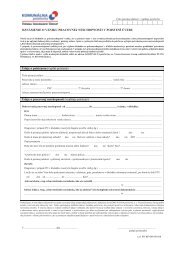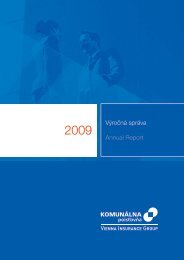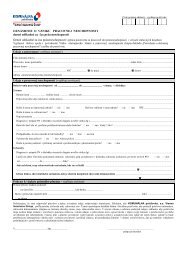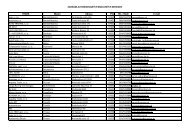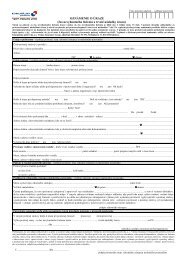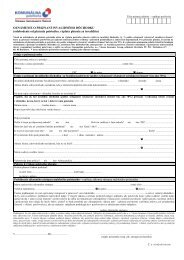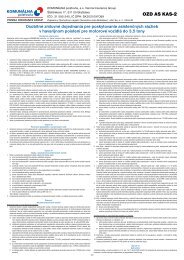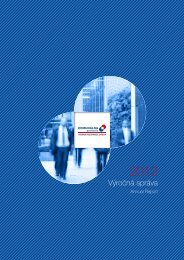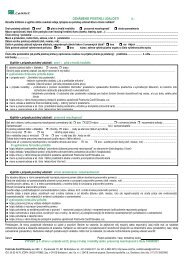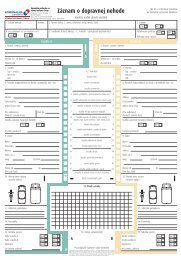kontinuita - Komunálna Poisťovňa
kontinuita - Komunálna Poisťovňa
kontinuita - Komunálna Poisťovňa
Create successful ePaper yourself
Turn your PDF publications into a flip-book with our unique Google optimized e-Paper software.
NOTES TO<br />
THE FINANCIAL<br />
STATEMENTS<br />
as the current contractual interest rate. The Company<br />
may also determine the amount of the impairment loss<br />
as the difference between the financial asset’s fair<br />
value set on the basis of its market price and financial<br />
asset’s carrying amount.<br />
If, in a subsequent period, the amount of the impairment<br />
loss decreases and this decrease is objectively<br />
related to an event that had occurred after the impairment<br />
was recognized (such as improved credit rating of<br />
the debtor or issuer), the reported impairment loss is<br />
reversed by adjusting the allowance account. The<br />
amount of the reversal is recognized in the income<br />
statement.<br />
(ii) Financial assets carried at fair value<br />
The Company assesses at each balance sheet date<br />
whether there is an objective indication that a financial<br />
asset is impaired. In the case of equity securities classified<br />
as available for sale, a prolonged or significant<br />
diminution in the fair value of the security below its<br />
cost is taken into account. If any such evidence exists<br />
for financial assets available for sale, the cumulative<br />
loss – measured as the difference between the acquisition<br />
cost and current fair value, less any impairment<br />
loss on the financial asset previously recognized in<br />
profit or loss – is removed from valuation variances in<br />
equity and recognized in the income statement. Impairment<br />
losses on equity instruments that are recognized<br />
in the income statement are not reversed to the<br />
income statement. The impairment loss on debt securities<br />
is reversed through the income statement if, in a<br />
subsequent period, the fair value of a debt instrument<br />
increases and this increase objectively relates to an<br />
event that had occurred after the impairment loss was<br />
recognized in profit or loss.<br />
(iii) Impairment of other non-financial assets<br />
Assets that have an indefinite useful life are not amortized;<br />
however, they are tested for impairment every<br />
year. Assets that are subject to amortization are reviewed<br />
for impairment whenever events or changes in<br />
circumstances indicate that the carrying amount may<br />
not be recoverable. An impairment loss is recognized<br />
at the amount by which the asset’s carrying amount<br />
exceeds its recoverable amount. The recoverable<br />
amount is the higher of an asset’s fair value less costs<br />
to sell and value in use. For the purposes of assessing<br />
impairment, assets are grouped at the lowest levels for<br />
which separately identifiable cash flows (cash-generating<br />
units) exist. Impaired non-monetary assets other<br />
than goodwill are reviewed at each balance sheet date<br />
to establish whether or not the impairment can be reversed.<br />
2.7 Offsetting financial instruments<br />
Financial assets and liabilities are offset and the net<br />
amount is reported in the balance sheet only when<br />
there is a legally enforceable right to offset the recognized<br />
amounts and there is an intention to settle on a<br />
net basis, or to realize the asset and settle the liability<br />
simultaneously.<br />
2.8 Cash and cash equivalents<br />
Cash and cash equivalents include cash in hand, sight<br />
deposits with banks, and other high-liquid investments<br />
with original maturity up to three months.<br />
2.9 Share capital<br />
Ordinary shares are classified as share capital. Additional<br />
costs directly attributable to the issue of new equity<br />
securities are shown in equity as a deduction, net<br />
of tax, from the proceeds.<br />
2.10 Insurance and investment contracts<br />
The Company concludes contracts that transfer insurance<br />
risk or financial risk or both.<br />
Contracts in which the Company assumes significant insurance<br />
risk of a third party (policyholder) and agrees<br />
KONTINUITA ANNUAL REPORT 109



